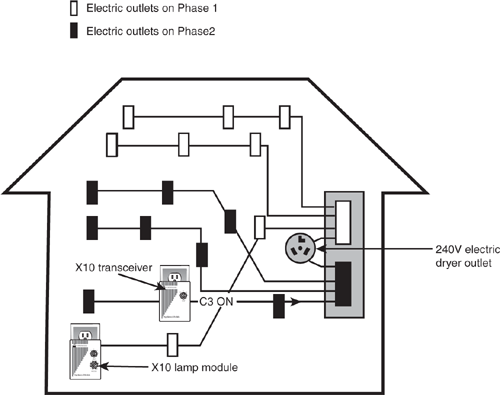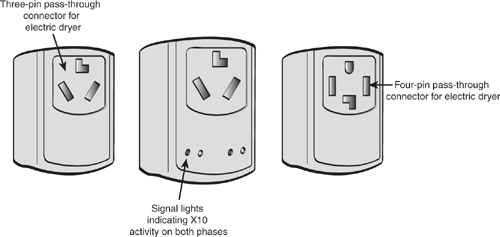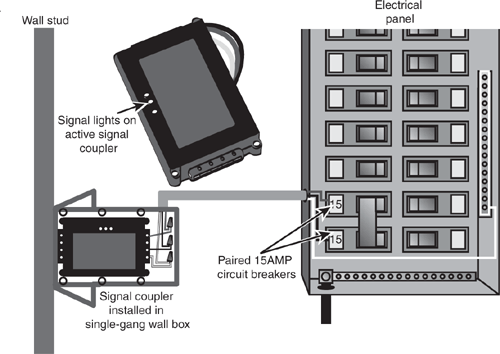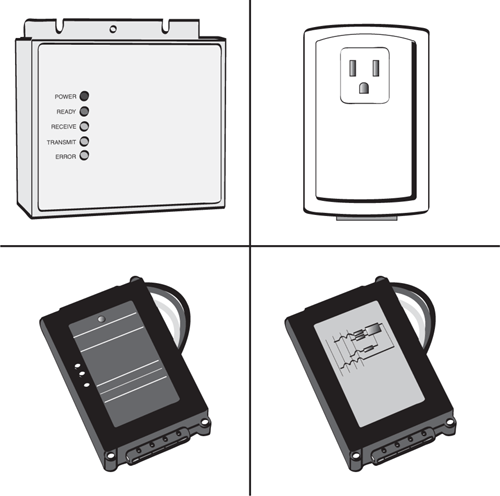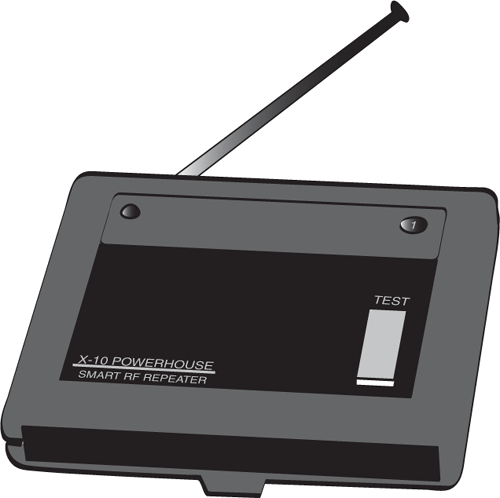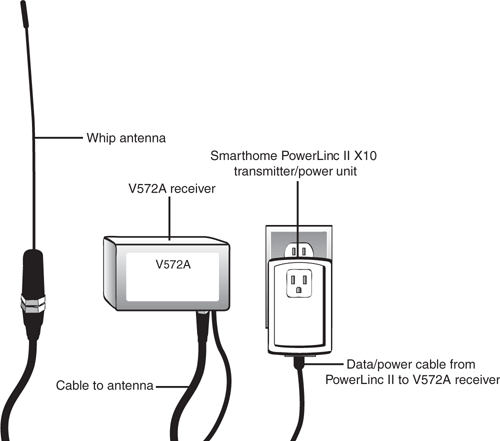Whether you’re having problems with an X10 installation, range problems with X10 transceivers, or you’re tired of installing multiple transceivers for different house codes, you’ve come to the right place for help.
X10 is a power line carrier (PLC) automation system. Because X10 uses power lines to carry signals, issues involving power lines could cause problems with X10. Some issues you might encounter include
House wiring usually involves a single 240-volt AC service that has been split into two 120-volt AC phases (a system known as single split-phase). If an X10 controller or transceiver is plugged into wiring connected to one phase, and some of the receivers are plugged into wiring connected to another phase, the controller or transceiver’s signals might not reliably reach some receivers.
House wiring can be electrically noisy. Interference caused by loose outlets or switches, refrigerators, or vacuum cleaners can disrupt X10 signals.
X10 transmitters such as transceivers and two-way light switches and appliance modules can absorb X10 signals. If too much of the X10 signal is absorbed before it reaches the destination module, the module might not receive the signal.
X10 power line signals can travel between homes and apartments, so the X10 modules in your location might be triggered by signals from elsewhere.
Other issues with your X10 installation might include
By default, virtually all X10 modules, switches, transceivers, remotes, and tabletop controllers are set to house code A. If you don’t change your house code to a different value, it’s possible that your transceiver might pick up signals from a nearby home or apartment that also uses X10 home automation. Although a few X10-compatible systems such as Black & Decker freewire and HomeAuto feature transceivers with security codes, standard X10 and X10-compatible transceivers do not use security codes.
If you have a large home (more than 2,500 square feet) or a home with brick or concrete walls, you might have problems sending or receiving X10 signals with conventional transceivers and remotes.
With only 16 unit codes per house code, it’s likely that you’ll need to use two or more house codes for a large-scale automation project. If you use conventional tabletop controllers or transceivers, you must use a separate unit for each house code you want to control or else turn the house code dial every time you want to control devices on another house code. This can create confusion and inconvenience.
If you are working with a module in a remote part of your home, or you are controlling your home via an Internet connection, conventional X10 modules do not provide feedback of status or problems. You might not know whether your signal reached the module.
If any of these issues are problems for you, this appendix can help.
X10 is a PLC technology. Even if you use a wireless transceiver and remote control to run your X10 system, the transceiver sends signals via your home’s AC wiring to the module you want to operate. The following sections discuss various tools and devices you can use to diagnose and solve problems with the reliable transmission of X10 PLC signals in your home.
Homes in North America are typically wired with two 120-volt AC lines split from an incoming 240-volt AC service. This is known as single split-phase or two-phase wiring. Some AC outlets are wired to one phase and some to another. Although normal electrical outlets in your home use 120-volt AC power, you probably also have one or more 240-volt AC outlets for an electric range, a clothes dryer, or a high-powered window air conditioner.
In a typical home automation installation, some X10 or X10-compatible modules, transceivers, and desktop controllers are likely to be plugged into one phase and some into the other. If the two 120-volt AC lines are not coupled correctly, signals sent from a controller or transceiver on one phase might not be received correctly by modules on the other phase (see Figure B.1).
If X10 modules work erratically when you are not using a 240-volt appliance such as an electric range or clothes dryer, but work very well when you are cooking or drying clothes, you have a problem with phase coupling.
At one time, phase coupling problems required installation of a phase coupler (also referred to as a signal bridge) into your electrical panel. Hardwired phase couplers are still available. However, you can now use a plug-in phase coupler instead if you have a suitable 240-volt electric outlet. A plug-in phase coupler connects to a 240-volt electric clothes dryer outlet to provide a reliable connection between the two 120-volt phases (see Figure B.2). Use the pass-through outlet on the front of the phase coupler (see Figure B.3) for your electric dryer.
Phase couplers are available in passive models (recommended for houses up to 3,000 square feet) and active models that also act as signal boosters and repeaters (for larger homes). Table B.1 lists plug-in phase couplers, and Table B.2 (in the next section) lists active phase couplers and other types of signal boosters.
Table B.2. X10 Signal Boosters and Active Phase Couplers
Vendor | Model# | Features | Service Type | How Installed |
|---|---|---|---|---|
Advanced Control Technologies Inc. | HomePro CR230 | Provides signal coupling | Two-phase | Hardwired |
HomePro CR234 | Can work with other signal boosters; provides signal coupling | Two-phase | Hardwired | |
HomePro CR134 | Can work with other signal boosters; provides signal coupling | Three-phase | Hardwired | |
Smarthome | BoosterLinc 4827 | Can work with other signal boosters; includes X10 test signal generator | Either | Grounded AC outlet |
ToggleLinc two-way wall switch 23890 (dimmer), 23893 series | Incorporates BoosterLinc signal booster (can be disabled) | Two-phase | Three-wire light switch wall box | |
X10 Pro | XPCR | Provides signal coupling | Either | Hardwired |
Leviton | HCA02 | Provides signal coupling; includes X10 test signal generator | Two-phase | Hardwired |
Figure B.3 compares plug-in signal couplers.
Although passive signal couplers can significantly improve X10 reliability, they might not solve every problem associated with X10 signals. Every X10 transceiver and controller, and two-way switches or modules in use absorb some of the X10 signals being transmitted through house wiring. In addition, many other types of electronic equipment can cause interference with X10 signals (see the “Using Noise Filters” section later in this appendix for details).
If X10 signals are too weak for reliable operation in some parts of the home and a passive signal coupler has already been installed, consider adding a signal booster (amplifier) to your X10 home automation system. Signal boosters are designed to detect X10 signals as low as 100mV and boost them to 5V AC (120-volt systems).
Signal boosters are available in plug-in modules for use in 120-volt AC electrical outlets that are not used by other X10 modules, transceivers, or controllers. They’re also available in hardwired devices (these also include phase coupling) and are sometimes incorporated into switches.
Some signal boosters are designed to be the only signal booster in use, whereas others are designed for very large (4,000 square feet and more) homes where another signal booster might already be in use. Signal boosters designed for use in addition to another booster can be configured to ignore already-boosted signals.
If want to use X10 to control modules in an apartment or a commercial building, these structures typically use three-phase wiring. To boost signal strength in a three-phase installation, you must use a signal booster that supports three-phase service (see Table B.2). Table B.2 lists some of the signal boosters and active phase couplers available in the United States.
Figure B.4 shows an installed Leviton HCA02 hardwired signal coupler. Installation is similar for other hardwired active and passive signal couplers.
Figure B.5 illustrates the devices listed in Table B.2.
If your X10 home automation system was working well until you brought home a new electronic device and plugged it in, electrical interference from the new device is the most likely culprit. From rechargers for electric toothbrushes and other battery-powered devices to computer monitors, many different types of electronic devices can interfere with X10 signals, even when the device is turned off.
To determine which devices are causing interference, unplug each device, and then retry sending X10 commands. When you unplug the devices that were causing interference, your X10 performance will become noticeably more reliable. You can also use a signal meter to determine signal quality. For more information, see the “Testing X10 Signal Quality” section later in this appendix.
To enable you to reconnect problem devices and still have reliable X10 performance, install AC line filters that start working at the 100kHz frequency and connect the problem devices to the line filters. Surge suppressors with noise filtration starting at 100kHz or lower (not higher) can also be used. Table B.3 lists some of the common plug-in and wired-in line filters that can be used with X10.
Table B.3. Line Filters for Use with X10 Systems
Vendor | Model# | Max Electrical Load | How Installed |
|---|---|---|---|
Advanced Control Technology, Inc. | HomePro AF100 | 5 amp | Plug-in (three-wire AC outlet) |
HomePro AF120 | 15 amp | Plug-in (three-wire AC outlet) | |
Leviton | 6288 | 5 amp | Plug-in (three-wire AC outlet) |
6287[1]. | 5 amp | Hardwired | |
6289[2]. | — | Hardwired | |
Smarthome | 1626 | 5 amp | Plug-in (three-wire AC outlet) |
X10 Pro | XPF[3] | 20 amp | Hardwired |
X10 Pro | XPPF | 5 amp | Plug-in |
[1] Designed to handle electrical noise problems caused by low-voltage, HID (high-pressure discharge) and fluorescent lighting, and small electrical motors [2] Designed for higher-amp devices than Leviton 6287 [3] Designed for use with large appliances such as refrigerators, hot tubs, and so forth. | |||
X10 power line signals can travel from house to house via the electrical service connections. If X10 modules in your home are turning on and off when they should not, it’s possible that X10 signals from a nearby location have entered your electrical wiring.
To stop X10 signals from another home from entering your home wiring, ask a professional electrician to install a passive blocking filter such as the X10 Pro PZZ01 or the similar Leviton 6284. Passive blocking filters must be installed over the neutral wire where the electric service enters your building.
These devices also prevent X10 signals from leaking from your home via the electrical panel and provide passive signal coupling.
You should also consider using a house code other than A for your home automation system. Almost all X10 and X10-compatible modules are set to house code A by default. Some users might not select a different house code, and if you and a neighbor both use wireless transceivers set to house code A, you might accidentally control each others’ modules. Use other house codes than A, and you substantially reduce the odds of AC or wireless signals from other X10 users’ interfering with your installation.
If you’re planning to use X10 for a large-scale automation project (such as several rooms or your entire home), you might want to consider adding an X10 signal tester to your toolkit. And, if you’re already in the midst of X10 automation that’s not always working as well as you’d like, testing X10 signal quality can help you determine what the best solutions are.
Although many X10 signal testers are priced at more than $200, making them more suitable for use by professional installers, some testers are available for $100 or less. Smarthome’s TesterLinc (#4819) works with the Smarthome PowerLinc II (#1132B) to determine signal addresses received, signal quality, and line noise. Elk Products’ ESM1 Signal Meter indicates with a green LED whether a valid X10 signal has been received and also indicates the strength of the X10 signal. It is best used with a plug-in X10 controller that can send a continuous stream of signals such as an X10 Powerhouse Powerflash Interface (PF284) when set to mode 2. Figure B.6 illustrates the ESM1 receiving a good-quality X10 signal.
If you are a professional X10 installer, you might prefer to use one of the professional-level X10 signal testers shown in Table B.4.
Table B.4. Professional X10 Signal Testers
Vendor | Model# | Features |
|---|---|---|
Advanced Control Technologies, Inc. | AT004 | Transmits and receives X10 standard and extended signals, displays noise and signal level, logs test results for up to 24 hours, and more. Can be connected to AC outlet or electrical panel. |
Leviton | 6385 Signal Strength Transmitter | Transmitter sends P1 house/unit code combination to indicator; indicator displays signal strength, noise level detected where connected. |
6386 Signal Strength Indicator | The Leviton HCA02 signal coupler can be used in place of 6385 as a source for signals. | |
Marrick Limited, Inc. | LynX-TOOLS | Bundles LynX-10 PLC X10- vcompatible PC-based transceiver with LynX-View software and other utilities to monitor signals, noise, and X10 packets. Supports Lightolier Compose codes. |
Monterey Instruments | Powerline Signal Analyzer | Provides bit-level examination of X10 signal packets, signal strength, preset dim, extended data, command log option; identifies specific X10 error codes, and more. |
X10 Pro | XPTT | Transmitter sends P1 house/unit code combination to indicator; indicator displays signal strength, noise level detected where connected (same as Leviton 6385) |
XPTR | Indicates signal strength; plugs into AC outlet (same as Leviton 6386) |
Most X10 and X10-compatible starter kits include a wireless transceiver and remote control. However, unlike IR remotes that are used a few feet away from the receiver built into a TV, VCR, boom box, or DVD player, X10 remotes use radio-frequency signals that might be transmitted from several rooms away or from outside. Making sure that wireless X10 signals are to the transceiver from the remote can be a challenge. The following sections will help you meet that challenge.
If you sometimes find yourself walking toward an X10 transceiver in another room to get your X10 remote to turn on the lights or the radio, you should consider a wireless signal repeater. Wireless signal repeaters retransmit wireless signals from X10 or X10-compatible remotes for more reliable reception by X10 or X10-compatible wireless transceivers.
Up to four SR371 wireless repeaters from X10 (USA) can be used in a single location, providing coverage for up to 80,000 square feet. A single SR371 can be used with an X10 security console. In practice, a single repeater boosts the connection range by about 100 feet. If more than one repeater is used, adjust the four-position dial (A-B-C-D) on each repeater to a unique setting. Figure B.7 shows an SR371 wireless repeater (also known as the X10 Pro PSX01) .
If you use more than one house code in your X10 home automation system and you use wireless transceivers and remotes, you have a problem. Standard wireless transceivers support only one house code. Therefore, you have to install an additional transceiver for each additional house code you want to use.
Additional transceivers can be hard to place in a central location, and can prevent you from using an electrical outlet in the way you prefer. As an alternative, consider using a single transceiver capable of receiving all house codes, such as the WGL & Associates V572 Whole House Transceiver, the Leviton HCPRF, or the X10 CM15A (which also provides PC-USB interfacing and is included as part of X10’s Active Home Pro home automation system).
The WGL & Associates V572 Whole House Transceiver is available with a self-contained antenna (V572TW) or an external antenna for boosting range (V572A). The V572 must be connected to one of the following X10 or X10-compatible two-way modules for interfacing to AC power lines:
X10’s TW523 (or the similar X10 Pro PSC05); bundle available from many different vendors
Smarthome’s PowerLinc II (bundle available from Smarthome)
When used with the TW523/PSC05, the V572 must be connected to an AC power source. PowerLinc II provides power to the V572.
Because of the whip antenna used by the V572A, this unit could also be used as an alternative to repeaters. The vendor claims 150-foot range, but many users have had success at much longer ranges.
Figure B.8 shows a typical installation of the V572A.
The Leviton DHC HCPRF plugs directly into an AC outlet. Its integrated two-prong X10-compatible DHC transceiver is programmed with a transceiver or tabletop controller instead of with code wheels.
It accepts signals from any X10-compatible RF wireless remote, or you can use it with an X10/IR universal remote such as the companion Leviton DHC HCCUR remote.
The X10 CM15A is the hardware component of X10’s Active Home Professional PC–based home automation system (refer to Chapter 11, “Accessing X10 Home Control via Your Home Computer,” for details), providing USB interfacing to your X10 home automation system. However, it can also be used as an all-house-code transceiver without a PC. It works as a direct replacement for X10’s RR501 and TM751 transceivers. It also replaces the CM19A PC transceiver used to control wireless X10 cameras. For more information about the CM15A when used with Active Home Pro, see Chapter 11.

